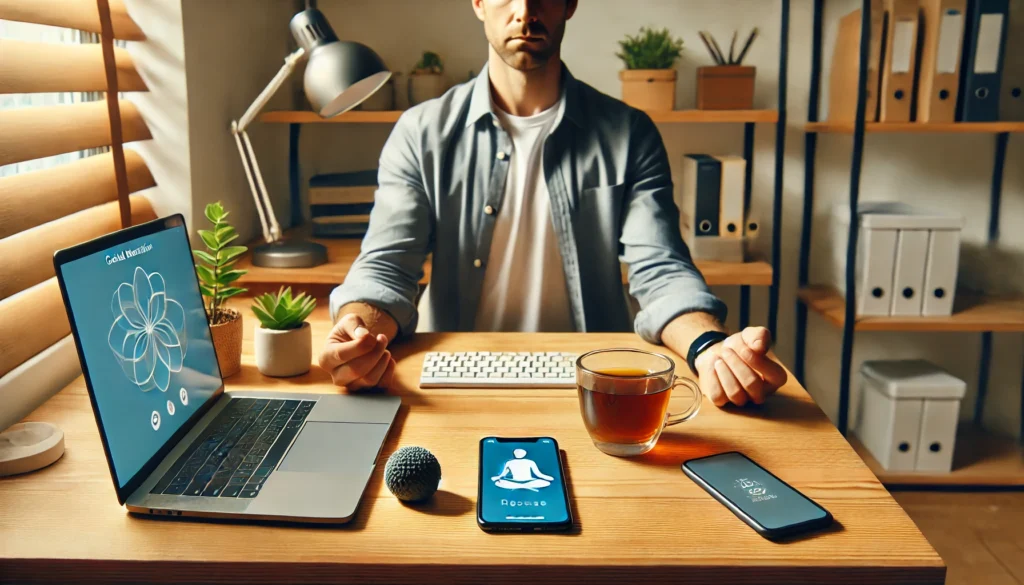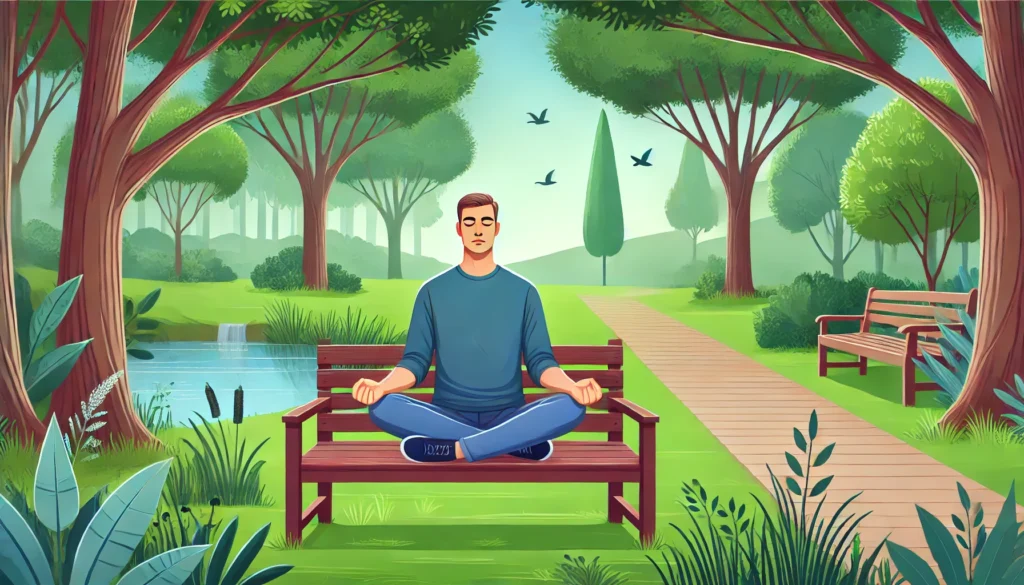Anxiety is a natural response to stress or perceived threats, characterized by feelings of tension, worried thoughts, and physical changes such as increased blood pressure. While occasional anxiety is normal, chronic anxiety can lead to disorders that require effective management strategies.
You may also like: Stress Relief: Sentences to Calm Your Mind
The Biological Basis of Anxiety
Anxiety is deeply rooted in our biology, with the brain’s amygdala and prefrontal cortex playing critical roles in the response to perceived threats. The amygdala detects danger and activates the body’s fight-or-flight response, while the prefrontal cortex helps regulate emotional reactions. Understanding these mechanisms can offer insights into why anxiety manifests and how it can be managed.
Psychological Factors Contributing to Anxiety
Psychological factors, such as past trauma, personality traits, and coping styles, can contribute to the development and persistence of anxiety. Individuals with a history of traumatic events or those with certain personality characteristics, such as perfectionism, may be more prone to anxiety. Exploring these factors can help tailor management strategies to individual needs.
Social and Environmental Influences
Social and environmental factors, including relationships, work stress, and lifestyle, can significantly impact anxiety levels. A supportive social network and a balanced lifestyle can act as buffers against anxiety, while toxic relationships or high-stress environments can exacerbate symptoms. Identifying these influences is crucial for effective anxiety management.
Historical Context and Current Trends
Historically, anxiety was often misunderstood and stigmatized. However, recent trends have shifted towards a more accepting and understanding view of mental health. With increased awareness, there is now a broader range of resources and techniques available for managing anxiety.
Evolving Perceptions of Anxiety
In the past, anxiety was often dismissed as mere nervousness or weakness, leading to widespread stigma. Today, there is a growing recognition of anxiety as a legitimate mental health concern, supported by scientific evidence. This shift has led to greater acceptance and a push for more comprehensive mental health education.
The Role of Media and Technology
Media and technology have played pivotal roles in shaping current perceptions of anxiety. Social media platforms and online communities have increased awareness and provided support networks for those struggling with anxiety. However, they can also contribute to anxiety through exposure to unrealistic standards and constant connectivity.
The Impact of Global Events
Global events, such as economic downturns and pandemics, have significantly influenced anxiety trends. These events can heighten stress levels and trigger anxiety in individuals who might not have experienced it otherwise. Understanding the impact of such events can guide the development of responsive anxiety management strategies.
Future Implications
As research in mental health continues to evolve, the future promises more personalized and effective anxiety management strategies. Advances in neuroscience and technology may offer new insights and tools for those struggling with anxiety.
The Promise of Personalized Medicine
Personalized medicine, which tailors treatment to individual genetic, environmental, and lifestyle factors, holds promise for anxiety management. By understanding the unique makeup of each person, treatments can be more effectively targeted, leading to better outcomes.
Technological Innovations in Mental Health
Technological advancements, such as mobile apps and virtual reality, are paving the way for innovative anxiety management tools. These technologies can offer new ways to practice coping skills, track anxiety symptoms, and even provide virtual therapy sessions, making mental health support more accessible.
The Role of Neuroscience in Anxiety Research
Neuroscience continues to expand our understanding of anxiety by exploring how brain structures and functions relate to anxiety symptoms. Future research may uncover new treatment targets and refine existing therapies, offering hope for more effective management of anxiety disorders.

Coping Skills for Anxiety
Developing coping skills is a crucial aspect of managing anxiety. These skills can help individuals navigate stressful situations and reduce anxiety symptoms.
Breathing Techniques
Breathing exercises are a simple yet effective way to manage anxiety. Techniques such as diaphragmatic breathing or the 4-7-8 method can help calm the nervous system and reduce anxiety symptoms. Practicing these techniques regularly can improve overall mental health.
Diaphragmatic Breathing
Diaphragmatic breathing, also known as deep belly breathing, involves inhaling deeply through the nose, allowing the diaphragm to expand fully. This technique engages the parasympathetic nervous system, promoting relaxation and reducing stress levels.
The 4-7-8 Breathing Method
The 4-7-8 breathing method, developed by Dr. Andrew Weil, involves inhaling for four seconds, holding the breath for seven seconds, and exhaling slowly for eight seconds. This method can help regulate breathing patterns and is particularly effective in moments of acute anxiety.
Incorporating Breathing into Daily Routine
Incorporating breathing exercises into daily routines can enhance their effectiveness. Practicing these techniques in a quiet space, during a commute, or even at work can make them a reliable tool for managing anxiety throughout the day.
Mindfulness and Meditation
Mindfulness and meditation are powerful tools for managing anxiety. These practices encourage individuals to focus on the present moment, reducing the tendency to overthink and worry. Regular meditation can decrease anxiety levels and improve emotional regulation.
Mindfulness Practices
Mindfulness involves paying attention to the present moment without judgment. Techniques such as mindful breathing, body scans, and mindful walking can help cultivate awareness and reduce anxiety by anchoring attention in the here and now.
Different Forms of Meditation
Various forms of meditation, such as guided meditation, loving-kindness meditation, and transcendental meditation, offer different approaches to anxiety management. Each form provides unique benefits, allowing individuals to find the practice that best suits their needs and preferences.
Incorporating Mindfulness into Everyday Life
Mindfulness can be integrated into everyday activities, such as eating, showering, or even brushing teeth. By bringing mindful attention to these routine tasks, individuals can cultivate a state of calm and presence that carries over into other areas of life.
Cognitive Behavioral Techniques
Cognitive Behavioral Therapy (CBT) is a widely used approach to managing anxiety. CBT techniques involve identifying and challenging negative thought patterns that contribute to anxiety. By restructuring these thoughts, individuals can reduce their anxiety symptoms.
Identifying Negative Thought Patterns
The first step in CBT is recognizing the negative thought patterns that fuel anxiety. Common patterns include catastrophizing, overgeneralizing, and all-or-nothing thinking. Understanding these patterns allows individuals to challenge and reframe them.
Techniques for Challenging Thoughts
Once negative thoughts are identified, CBT offers techniques for challenging them. This may involve questioning the evidence for a thought, considering alternative perspectives, or examining the worst-case scenario and its likelihood.
Restructuring Thought Processes
Restructuring involves replacing negative thoughts with more balanced, realistic ones. Over time, this practice can lead to a more positive and less anxious mindset, contributing to long-term anxiety management.
Physical Activity
Exercise is a natural and effective way to reduce anxiety. Physical activity increases the production of endorphins, which are chemicals in the brain that act as natural painkillers and mood elevators. Engaging in regular physical activity can significantly improve anxiety management.
Types of Exercise for Anxiety Reduction
Different types of exercise can be beneficial for anxiety management, including aerobic exercises like running or cycling, strength training, and yoga. Each type provides unique benefits and can be chosen based on personal preference and fitness levels.
The Mental Health Benefits of Exercise
Beyond its physical benefits, exercise can improve mental health by reducing stress, enhancing mood, and improving sleep quality. Regular physical activity can also boost self-esteem and provide a sense of accomplishment, contributing to overall well-being.
Incorporating Exercise into Daily Life
Incorporating exercise into daily life can be achieved through small changes, such as taking the stairs, going for a walk during lunch breaks, or engaging in a quick workout session at home. These activities can make exercise a consistent and enjoyable part of a daily routine.

Creating a Personalized Anxiety Management Plan
Anxiety management is not one-size-fits-all. It is important to create a personalized plan that incorporates various techniques and strategies tailored to individual needs.
Identifying Triggers
Understanding what triggers anxiety is the first step in managing it effectively. Keeping a journal of anxiety episodes can help identify patterns and specific triggers. Once identified, individuals can develop strategies to avoid or cope with these triggers.
Common Anxiety Triggers
Common triggers for anxiety can include specific situations, such as public speaking or crowded places, as well as internal factors like negative self-talk or physical health issues. Identifying these triggers helps in creating targeted management strategies.
Tools for Tracking Anxiety Triggers
Various tools, such as apps and journals, can assist in tracking anxiety triggers. These tools allow individuals to record their experiences, identify patterns, and reflect on their responses, providing valuable insights for managing anxiety.
Strategies for Managing Triggers
Once triggers are identified, individuals can develop strategies to manage them. This might involve avoiding certain situations, practicing coping techniques beforehand, or gradually exposing oneself to the trigger in a controlled manner.
Developing a Routine
Establishing a daily routine can provide structure and stability, reducing anxiety. Incorporating regular sleep patterns, balanced nutrition, and scheduled relaxation time can contribute to overall well-being.
The Importance of Routine in Anxiety Management
A well-structured routine can help reduce uncertainty and increase feelings of control, which are crucial in managing anxiety. A consistent daily schedule can help stabilize mood and reduce stress.
Incorporating Relaxation Techniques
Including relaxation techniques, such as yoga, deep breathing, or leisure activities, in a daily routine can enhance its effectiveness. Regular relaxation breaks can prevent anxiety from building up and provide a sense of balance.
The Role of Nutrition and Sleep
Balanced nutrition and adequate sleep are foundational to anxiety management. A diet rich in whole foods and regular sleep patterns can improve physical health and reduce anxiety symptoms, contributing to overall mental well-being.
Seeking Professional Support
In some cases, professional support from a therapist or counselor may be necessary. Mental health professionals can provide valuable insights and guidance in developing effective anxiety management strategies.
When to Seek Professional Help
Recognizing when to seek professional help is crucial. If anxiety significantly impacts daily functioning or persists despite self-help efforts, consulting a mental health professional can provide the support needed.
Types of Professional Support
Various forms of professional support are available, including therapy, counseling, and medication. Each type offers different benefits, and a mental health professional can help determine the best approach based on individual needs.
Integrating Professional Support with Self-Help
Professional support can be effectively integrated with self-help techniques to enhance anxiety management. Combining therapy with personal coping strategies can provide a comprehensive approach to managing anxiety.
Practical Exercises for Anxiety Management
Incorporating practical exercises into daily life can enhance anxiety management efforts. Here are some exercises to consider:
Progressive Muscle Relaxation
Progressive muscle relaxation involves tensing and then slowly releasing each muscle group in the body. This technique helps reduce physical tension and promotes relaxation, aiding in anxiety management.
The Science Behind Progressive Muscle Relaxation
Progressive muscle relaxation works by interrupting the stress response and promoting a state of relaxation. By focusing on physical sensations, it can help divert attention from anxious thoughts and reduce overall tension.
Step-by-Step Guide to Progressive Muscle Relaxation
A step-by-step approach to progressive muscle relaxation involves starting at one end of the body, such as the feet, and gradually working up. Tensing each muscle group for a few seconds before releasing helps achieve a state of deep relaxation.
Incorporating Relaxation into Daily Practice
Incorporating progressive muscle relaxation into daily practice can enhance its benefits. Practicing this technique before bed or during breaks can help reduce accumulated stress and promote a sense of calm.
Visualization Techniques
Visualization involves imagining a peaceful scene or situation. This technique can help distract from anxiety-inducing thoughts and promote relaxation. Practicing visualization regularly can improve mental well-being.
The Benefits of Visualization for Anxiety
Visualization can help shift focus away from anxiety and create a mental escape to a peaceful place. This mental imagery can reduce stress and promote relaxation, making it a valuable tool for anxiety management.
Steps to Practice Visualization
Practicing visualization involves selecting a calming scene, closing the eyes, and vividly imagining the details, such as sights, sounds, and smells. Engaging all senses can enhance the effectiveness of this technique.
Integrating Visualization into Daily Life
Integrating visualization into daily life can be achieved through short sessions, such as during a commute or before a stressful meeting. Regular practice can help make visualization a reliable strategy for managing anxiety.
Journaling
Writing down thoughts and feelings can be a therapeutic way to manage anxiety. Journaling allows individuals to express emotions and gain insight into their thought patterns, reducing anxiety symptoms.
The Therapeutic Value of Journaling
Journaling provides an outlet for expressing emotions and processing thoughts, which can reduce anxiety. By articulating feelings on paper, individuals can gain clarity and perspective, aiding in emotional regulation.
Different Approaches to Journaling
Various journaling approaches, such as gratitude journaling, free writing, and goal setting, offer different benefits. Each approach can help individuals explore their thoughts and emotions in unique ways, contributing to anxiety management.
Making Journaling a Habit
Making journaling a habit involves setting aside regular time for writing and finding a comfortable space. Consistency in journaling can enhance its therapeutic benefits and make it an integral part of anxiety management.

Resources for Further Support
There are numerous resources available for those seeking to manage anxiety. Books, online courses, and support groups can provide additional information and support for individuals looking to improve their anxiety management skills.
Online Courses and Workshops
Online courses and workshops on anxiety management offer structured learning opportunities and access to expert advice. These resources can provide valuable insights and practical tools for managing anxiety effectively.
The Benefits of Online Learning
Online courses offer flexibility and accessibility, allowing individuals to learn at their own pace. They often include interactive components, such as quizzes and forums, which can enhance understanding and engagement.
Popular Online Platforms for Mental Health
Various platforms, such as Coursera, Udemy, and Skillshare, offer courses on anxiety management. These platforms provide a wide range of resources, from beginner guides to advanced techniques, catering to diverse needs.
Choosing the Right Course
Choosing the right online course involves considering personal learning goals, course content, and instructor expertise. Reading reviews and exploring course previews can help individuals select the best fit for their needs.
Support Groups and Community Resources
Support groups and community resources provide a sense of connection and shared experience for those managing anxiety. These groups can offer emotional support, encouragement, and practical advice.
The Role of Support Groups in Anxiety Management
Support groups provide a safe space to share experiences and gain insights from others facing similar challenges. They can reduce feelings of isolation and offer a sense of belonging, which are important for managing anxiety.
Finding Local and Online Support Groups
Local community centers and mental health organizations often host support groups, while online platforms like Meetup and Facebook offer virtual groups. Exploring different options can help individuals find a supportive community.
Integrating Support Groups into a Management Plan
Integrating support groups into an anxiety management plan involves regular participation and active engagement. Sharing experiences and learning from others can complement individual coping strategies and enhance overall management efforts.
Downloadable PDFs
For those interested in structured resources, downloadable PDFs on coping skills and techniques can be a valuable tool. These documents often include practical exercises and strategies for managing anxiety effectively.
The Convenience of Downloadable Resources
Downloadable PDFs provide convenient access to structured information, allowing individuals to explore anxiety management techniques at their own pace. They can be accessed on various devices, making them easily portable.
Popular Topics Covered in PDFs
Common topics in downloadable PDFs include breathing exercises, mindfulness practices, and cognitive restructuring techniques. These resources often provide step-by-step guides, making them accessible to individuals at all levels.
Using PDFs as Part of a Management Plan
Using PDFs as part of an anxiety management plan involves integrating the exercises and strategies into daily routines. Regular practice and reflection on these techniques can enhance their effectiveness and contribute to long-term anxiety management.
Conclusion
Managing adult anxiety requires a comprehensive approach that incorporates various techniques and strategies. By understanding the nature of anxiety and developing personalized coping skills, individuals can improve their mental well-being and lead more fulfilling lives. The journey to managing anxiety is ongoing, but with the right tools and support, it is entirely achievable.
Embracing a Holistic Approach
A holistic approach to anxiety management considers the interplay of biological, psychological, and social factors. By addressing all these aspects, individuals can create a balanced and effective strategy for managing anxiety.
The Importance of Consistency and Patience
Consistency and patience are key in anxiety management. Regular practice of coping skills and techniques can lead to gradual improvements, while patience allows individuals to navigate setbacks and continue progressing.
The Role of Support in Anxiety Management
Support from family, friends, and mental health professionals is invaluable in managing anxiety. Encouragement and understanding from loved ones, combined with professional guidance, can provide a strong foundation for effective anxiety management.
Further Reading:
35 Anxiety Coping Skills: A List of Effective Remedies
Effective Coping Strategies for Adult Anxiety & Stress
How to Calm Down: 11 Coping Skills for Anxiety
Important Note: The information contained in this article is for general informational purposes only, and should not be construed as health or medical advice, nor is it intended to diagnose, prevent, treat, or cure any disease or health condition. Before embarking on any diet, fitness regimen, or program of nutritional supplementation, it is advisable to consult your healthcare professional in order to determine its safety and probable efficacy in terms of your individual state of health.
Regarding Nutritional Supplements Or Other Non-Prescription Health Products: If any nutritional supplements or other non-prescription health products are mentioned in the foregoing article, any claims or statements made about them have not been evaluated by the U.S. Food and Drug Administration, and such nutritional supplements or other health products are not intended to diagnose, treat, cure, or prevent any disease.


